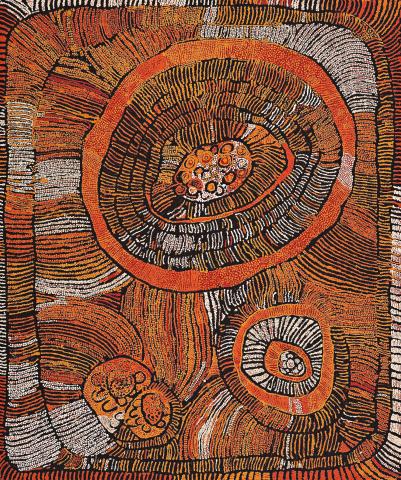THE SOAKAGE WATER SITE OF UNKUNYA, WEST OF THE POLLACK HILLS IN WESTERN AUSTRALIA, 2005
NAATA NUNGURRAYI
synthetic polymer paint on linen
181.0 x 152.0 cm
bears inscription verso: artist’s name and Papunya Tula Artists cat. NN0502037
Painted at Kintore in February 2005
Papunya Tula Artists, Alice Springs
Sotheby's, Melbourne, 24 July 2007, lot 101
The Luczo Family Collection, USA
22nd National Aboriginal and Torres Strait Islander Art Award, Museum and Art Galleries of the Northern Territory, Darwin, 19 August – 23 October 2005
Abstraction and the Dreaming: Aboriginal Painting from Australia’s Western Desert, (1971 – Present), Nora Eccles Harrison Museum of Art, Utah State University, Logan, Utah, USA, 9 November – 12 December 2015
Untitled, 1999, illus. in Perkins H. and H. Fink, Papunya Tula: Genesis and Genius, Art Gallery of New South Wales in Association with Papunya Tula Artists, Sydney, 2000, p. 145
Rockhole and Soakage Site of Marrapinti, 2005, illus. in Pintupi: 20 Contemporary Paintings from the Pintupi Homelands, exhibition catalogue, Hamiltons Gallery, London, 28 June – 11 August 2006, cat. 13
This painting is accompanied by a certificate of authenticity from Papunya Tula Artists that states: ‘This painting depicts designs associated with the soakage water site of Unkunya, west of the Pollock Hills in Western Australia. The Two Snake Dreaming passed through this site after travelling from far in the east. The soakages at the site, represented by the large roundels, were said to have been formed by the two snakes at the point where they went underground. In mythological times many women travelled through this site from the west on their way to Marrapinti. At Marrapinti the women made nose-bones which are worn through a hole in the nose-web. These nose-bones were originally worn by both men and women but are now only worn by the older generation on ceremonial occasions. The women later travelled east passing through Ngaminya and Wirrulnga collecting edible berries known as kampurarrpa or desert raisin from the small shrub Solanum centrale which grows nearby.
Naata Nungarrayi is a singular figure among senior Pintupi women. Initially reticent as an artist, Naata emerged as the boldest of the women who commenced painting at Kintore in the mid 1990s. As Luke Scholes observes, Naata first ‘worked slowly on small compositions of lines and roundels that loosely reflected the classic Tingari paintings made famous by the male painters of Papunya Tula… As Naata’s confidence grew, so did her presence among the painters. She developed a unique iconography, teeming with giant ‘U’ shape, mollusc-like forms depicted rocky outcrops and deep-etched lines representing the surrounding sandhills which bulge like the scars on arm or cleavage’. 1
Naata’s paintings possess an irrepressible, unbounded energy. In a similar vein to the western technique of ‘action painting’, the surfaces of her canvases arise from unrestrained gesture and the visceral memory of place. The earth in Naata’s hands is not cast as a stable geomorphological entity; rather sites such as Marapinti, Irrututu and Unkunya are experienced as turbulent, multi-facetted events, the living presence of ancestral heroes made manifest in the ongoing formation of the land. Here two ancestral snakes are envisaged entering the ground before travelling to Marapinti.
The concentricity of the ‘native well’ at Unkunya is deeply felt, for Naata has scooped out the soft earth of the soakage with a small hand-held dish — tapping into the dangerous subterranean home of the serpents. It is the sense of instability that makes Naata’s canvases particularly entrancing. Forms slip between positive and negative and push against one another before being drawn back into the earth, like a volcano swallowing its own lava.
Naata swings wildly between fleeting periods of distraction and hours of utter absorption. Her paintings are episodic, eruptive and passionate; they reflect her irascible nature. Naata paints a dangerously unpredictable country, each of her lines has its own character and her full-hued colours pop and explode. The Tjukurrpa (Dreaming) and its consequent manifestation as lived experience are impulsively expressed through Naata’s performance, as if painting were a ceremonial practice.
* I acknowledge the assistance of Fred Myers in cataloguing this work.
JOHN KEAN
1. Scholes, L., Naata Nungurrayi, Papunya Tula Artists, Alice Springs, 2011
